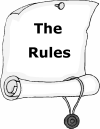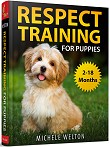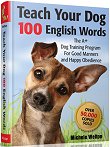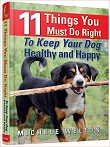Provide emotional security
By Michele Welton, Dog Trainer, Breed Selection Consultant, Author of 15 Dog Books
If you're following my health care program in order, we just talked about keeping your dog's body and mind fit through physical exercise and mental stimulation.
Your dog's physical and mental health are also affected by his emotional health.
There are two basic emotional states in dogs:
✔ calm/relaxed/secure
× or anxious/insecure
When your dog feels anxious and insecure, his body produces defensive biochemicals such as adrenaline and cortisol.
These potent biochemicals make his mind and body feel perpetually stressed and "wired", which can lead to digestive upsets, inflammatory health issues, and over-reactive or obsessive behaviors.
Causes of anxiety and insecurity in dogs
- Dogs feel anxious and insecure when their daily schedule is unpredictable and different things happen at different times in different ways.
- Dogs feel anxious and insecure when you haven't established black and white rules. The dog isn't sure which of his behaviors will result in a reward and which behaviors will result in a correction.
- Dogs feel anxious and insecure when you (or your spouse or kids) enforce the rules inconsistently or in different ways.
- Dogs feel anxious and insecure when they haven't been taught many words or skills so they can't understand what you want them to do or how to do it.
- Dogs feel anxious and insecure when they spend a lot of time outside alone.
- Dogs feel anxious and insecure when everyone works or goes to school all day. Canines are sociable animals, not solitary animals. Dogs left alone for 6+ hours a day are lonely and bored.
- Dogs feel anxious and insecure when their household becomes unharmonious. Family problems are hard on both children and sensitive dogs. Emotionally charged conversations or loud arguments should take place without children or dogs present.
 Dogs feel anxious and insecure when they're frequently petted, carried around, or cuddled on your lap. Over-dependency can lead to separation anxiety when you leave the dog alone. Dependent dogs are so accustomed to being the center of attention that they may become jealous (another form of anxiety and insecurity) when you pay attention to anyone else. Neediness and dependency are terrible for a dog's emotional health.
Dogs feel anxious and insecure when they're frequently petted, carried around, or cuddled on your lap. Over-dependency can lead to separation anxiety when you leave the dog alone. Dependent dogs are so accustomed to being the center of attention that they may become jealous (another form of anxiety and insecurity) when you pay attention to anyone else. Neediness and dependency are terrible for a dog's emotional health.- Dogs feel anxious and insecure when you fail to protect them from kids or other pets who are pestering or bullying them.
- Dogs feel anxious and insecure when they haven't been taken out into the world and taught how to behave around strangers, strange dogs, or unfamiliar places. When a dog acts inappropriately in public and you don't respond properly, he will progress from anxiety and insecurity to neurotic or aggressive behavior.
- Dogs feel anxious and insecure when they don't see you as the competent leader of the household. If you're not comfortable providing guidance and direction and setting firm boundaries, if you feel guilty about saying "No" to your dog and making it stick.... your dog will think that HE needs to take charge of every situation and make all the decisions. This is a stressful mindset for any dog because he isn't equipped to make decisions in our complicated world.
How to provide emotional security so your dog has a calm, relaxed state of mind
 Establish routines
Establish routines
As much as possible, your dog's daily schedule should be a series of established routines that happen the same way every day. Familiar routines reassure him that everything in his little world is predictable – the same as it was yesterday, and the same as it will be tomorrow. Routines reassure him that YOU are dependable, that he can count on you to say and do things that he understands. A dog feels calm, relaxed, and secure when he knows what happens next.
Set firm boundaries – Yes to this, No to that
Show your dog which of his behaviors will result in a reward and which behaviors will result in a correction. A dog feels calm, relaxed, and secure when he knows which behaviors are expected of him, and which behaviors he is NOT allowed to do.
Be completely consistent
If you tell your dog to do something (or not to do something), you must make absolutely sure he does it, or stops doing it. Family members should use the same words and commands, reward the same behaviors, and correct the same behaviors. Dogs feel uneasy with "maybes" and "sometimes." A dog feels calm, relaxed, and secure when he knows that the rules always apply, so he never needs to guess.
 Teach your dog new words and skills
Teach your dog new words and skills
Like anyone who learns a foreign language, when your dog learns what your human sounds mean, he feels more secure. Same with learning skills such as heel, sit, stand, stay, come, wait, fetch. Child psychologists say that telling a child he's "wonderful" isn't nearly as effective as praising something specific the child has accomplished. Kids prefer specific earned praise to vague gushy platitudes. So do dogs.
Keep your dog indoors with you
A dog feels calm, relaxed, and secure when he's a true member of your family. That means he lives in your house with you. A dog should only be outdoors for potty breaks, interactive play or exercise, or to lounge in the sun on a pleasant day while you're outside with him or just inside the house keeping an eye on him. When he's done, he should come back in.
Dogs who spend much of their day outdoors or in the basement or garage or separate kennel building are forced to live "outside" their pack, on the edge of it, never really immersed in day-to-day family life.
Provide a safe den
A dog feels calm, relaxed, and secure when he has a sanctuary all his own. If he finds his own private place and it's acceptable to you, put his blanket or bed there to encourage him to keep using it. I leave the doors to my dogs' crates open all day and they go in and out to rest and "recharge".
 Provide sufficient companionship
Provide sufficient companionship
Dogs are sociable animals, which means they feel calm, relaxed, and secure when they're with another member of their family most of the day. At the very least, a dog left alone for more than 6 hours a day should have canine companionship.
Encourage independence
Providing sufficient companionship doesn't mean your dog should frequently be held or carried, or cuddled on your lap, or petted every time he nudges your hand. A dog feels calm, relaxed, and secure in your presence, yes – but he should be standing on his own four feet most of the time.
Socialize your dog
A dog feels calm, relaxed, and secure when he knows how to behave in different social settings. Take him to the park, downtown, a shopping center and practice all the words and skills he knows ("Heel. Sit. Come."), providing treats and leash guidance to ensure that he pays attention to you and ignores everyone else.
Your goal is NOT to make your dog "friendly." Your goal is to teach him to behave (to pay attention, no barking, jumping, lunging) in different social settings. You want him to focus on you and simply "share space" with everyone else as though they were harmless background noise. He might like other people and other dogs.... or not. Either way, he must accept them without resorting to inappropriate behavior.
Protect the dog from children and other animals
A dog feels calm, relaxed, and secure when he sees that you will intervene if anyone pesters or bullies him or steals his food or toy.
Maintain household harmony
A dog feels calm, relaxed, and secure when family members get along and there is peace in your household.
 Provide calm, confident leadership
Provide calm, confident leadership
Show your dog that you're in charge of everything in his life, that everything good comes from you, and that he should look trustingly to you for guidance, direction, and permission. A relationship where you are the leader and he is the respectful follower is the relationship every dog thrives on. Step up and be the decision-maker. Show him the clear, black-and-white rules and routines he is to follow, and then make sure he does. When he is confident that you have everything under control, he will feel calm, relaxed, and secure.
You can learn how to do everything in this article by following my free online training programs. Follow my advice faithfully and you'll have a calm, relaxed, secure, and well-behaved dog!
My best-selling books – now available FREE on my website
 Respect Training For Puppies: 30 seconds to a calm, polite, well-behaved puppy is for puppies 2 to 18 months old. Your puppy will learn the 21 skills that all family dogs need to know. Click here to read for free.
Respect Training For Puppies: 30 seconds to a calm, polite, well-behaved puppy is for puppies 2 to 18 months old. Your puppy will learn the 21 skills that all family dogs need to know. Click here to read for free. Teach Your Dog 100 English Words is a unique Vocabulary and Respect Training Program that will teach your adult dog to listen to you and do what you say. Click here to read for free.
Teach Your Dog 100 English Words is a unique Vocabulary and Respect Training Program that will teach your adult dog to listen to you and do what you say. Click here to read for free. 11 Things You Must Do Right To Keep Your Dog Healthy and Happy helps your dog live a longer, healthier life. Get my honest advice about all 11 Things before you bring home your new puppy, because some mistakes with early health care cannot be undone. Click here to read for free.
11 Things You Must Do Right To Keep Your Dog Healthy and Happy helps your dog live a longer, healthier life. Get my honest advice about all 11 Things before you bring home your new puppy, because some mistakes with early health care cannot be undone. Click here to read for free.
